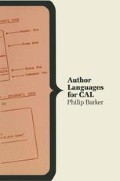Abstract
Most users of the computer are familiar with the commonest possible mode of human-computer interaction; keyboard input and screen output. Despite their simplicity, these methods of communication can be used to implement a wide variety of quite sophisticated learning and training tasks. There are, however, many situations in which one or other (or both) of these interaction devices is either inappropriate or insufficient. Consider, for example, the case of a blind student who is unable to read the material presented on a CRT display; how useful the provision of Braille or speech output might be. Again, consider the use of a computer in a primary school environment in which children’s keyboard dexterity might be quite minimal (often very slow and usually error prone); it is claimed that in such situations the use of a conventional keyboard can be detrimental to the very learning processes that the computer is attempting to promote. These two examples alone are sufficient to illustrate the inappropriateness of the keyboard/CRT combination within certain learning and teaching situations. Of course, many other examples could be cited.
Preview
Unable to display preview. Download preview PDF.
Author information
Authors and Affiliations
Copyright information
© 1987 Philip Barker
About this chapter
Cite this chapter
Barker, P. (1987). Multi-media CAL. In: Author Languages for CAL. Macmillan Computer Science Series. Palgrave, London. https://doi.org/10.1007/978-1-349-18519-1_4
Download citation
DOI: https://doi.org/10.1007/978-1-349-18519-1_4
Publisher Name: Palgrave, London
Print ISBN: 978-0-333-42540-4
Online ISBN: 978-1-349-18519-1
eBook Packages: Palgrave Social & Cultural Studies CollectionSocial Sciences (R0)

